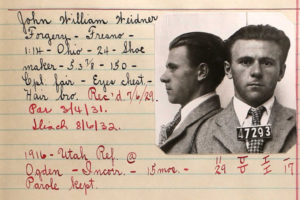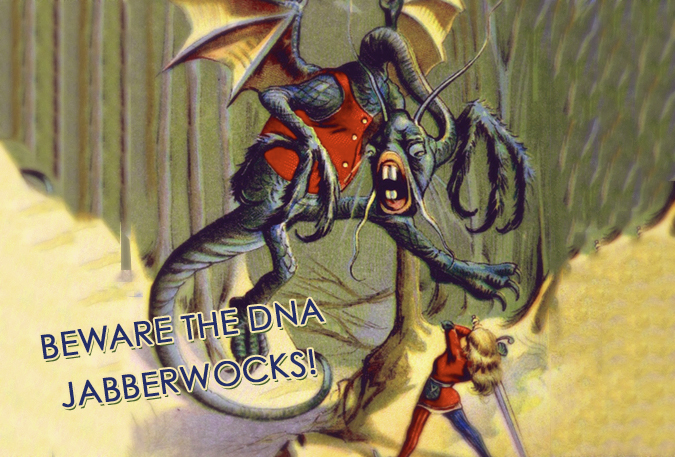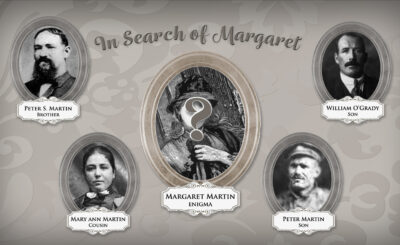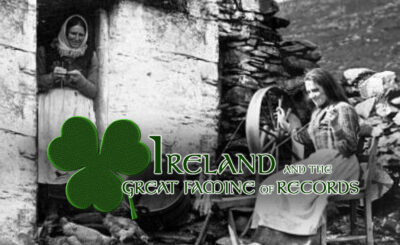’Twas brillig, and the slithy toves
Did gyre and gimble in the wabe:
All mimsy were the borogoves,
And the mome raths outgrabe.
“Beware the Jabberwock, my son!
The jaws that bite, the claws that catch!”
(“Jabberwocky,” Lewis Carroll)
Through the Looking Glass
Researching family history is sometimes like falling through Alice in Wonderland’s Looking Glass. You find yourself in a strange world, where everything you thought you knew you are no longer certain of. Each turn of the family history page may bring a new ancestor, another slice of history, strange marvels, and three new questions for everyone answered.
What’s not to love?
But it’s also wise to tread lightly at times. You never know when he will appear, so it’s best to beware the Jabberwock! The family history Jabberwocks are those unexpected turns of event that bite and claw, that turn families inside out, and make people stop responding to your requests for information. They’re the false trails you follow, ending up with seven generations of someone else’s ancestors! I’ve covered this topic elsewhere in terms of general unpleasant family news—now let’s address the potential Jabberwocks of DNA Testing.
See “Great-Grandmother Was Illiterate / a Convict / Married Seven Times!
Things to Beware!
- DNA does not lie, but it also is not a precise process. I know of two sisters who have both had their DNA tested through Ancestry: one has 198 fourth generation or closer matches; the other has 248. Obviously, any person related to one sister is related to the other, however, one has 20% more matches! The spectrum of DNA each has inherited is THAT different. Keep that in mind as you evaluate relationships and be careful making assumptions without other supporting evidence.
- You may discover a relation who is very surprised to be related to you, and not happy about what it reveals. You would think that anyone taking a DNA test WANTS to know about other family; that may have been true in theory, but once they meet the REAL person, Jabberwock can strike! Family relationships can be some of the most rewarding, but also can be the most painful of anything. You should always suspect the person you are wanting to connect with has family baggage, is carrying terrible wounds, may be about to lose his or her house, and is having the worst day ever at that moment! Then you may be pleasantly surprised! Be as kind and as patient as you can; consider every word before letting it loose to see if it holds ANY conceivable offense. You just never know.
- Because of the random aspect of chromosome splitting and recombining, you may very well be related to a person, but not be a DNA match. You may also be a match with someone, but related much further back then what the tests indicate. There are several reasons why your genetic distance appears different than it actually is. Especially if your family comes from a closed society where they lived for multiple generations, you may be “double-related” to your DNA matchee. So instead of being second cousins with a person, you may be third cousins on one line and fourth cousins on another, being related through multiple family lines and having multiple MRCAs. When this happens, the match appears to be stronger than it actually is because you are counting DNA donated by multiple ancestors.
- You will most probably have to reconsider some of the family lore. No, you’re not descended from an Indian Chief. No, great-grandma wasn’t a midwife; she spent most of her life in the workhouse. Yes, pious Aunt Mary had a child out of wedlock. Oh, and you’re not really Scottish; you’re Irish! Does that mean you need to lose those stories? I don’t think so! Let them be tall tales in the family repertoire. The wonderful thing is new information brings fantastic new stories to tell! And they’re true!


HOWEVER
Don’t let the Jabberwocks scare you away. Get out there and find your family! DNA testing, here we come!
See More: “Which DNA Kit Is Best?”
See More: “My DNA Test Is Back—Now What?”







